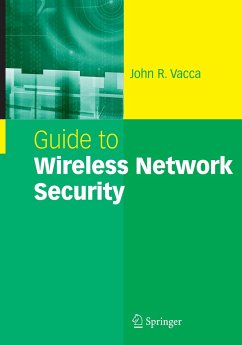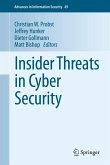With the rapid deployment of wireless networks in business environments, IT professionals must implement security mechanisms that are equivalent to those existing today for wire-based networks. This volume is an authoritative, clearly-presented guide to key foundation topics and technology frameworks for designing and maintaining secure, reliable operations. From basic concepts to designing principles to deployment, all critical concepts and phases are explained in detail. The book also includes coverage of wireless security testing techniques and intrusion prevention techniques.
Through extensive hands-on examples, Guide to Wireless Network Security demonstrates how to install, configure and troubleshoot firewalls and wireless network security applications; evaluate, implement and manage wireless secure remote access technologies; and deploy a variety of Virtual Private Networks, intrusion detection systems and intrusion prevention systems, in conjunction with information warfare countermeasures.
1. INTRODUCTION With the increasing deployment of wireless networks (802. 11 architecture) in enterprise environments, IT enterprises are working to implement security mechanisms that are equivalent to those existing today for wire-based networks. An important aspect of this is the need to provide secure access to the network for valid users. Existing wired network jacks are located inside buildings already secured from unauthorized access through the use of keys, badge access, and so forth. A user must gain physical access to the building in order to plug a client computer into a network jack. In contrast, a wireless access point (AP) may be accessed from off the premises if the signal is detectable (for instance, from a parking lot adjacent to the building). Thus, wireless networks require secure access to the AP and the ability to isolate the AP from the internal private network prior to user authentication into the network domain. Furthermore, as enterprises strive to providebetter availability of mission-critical wireless data, they also face the challenge of maintaining that data's security and integrity. While each connection with a client, a supplier or a enterprise partner can improve responsiveness and efficiency, it also increases the vulnerability of enterprise wireless data to attack. In such an environment, wireless network security is becoming more important every day. Also, with the growing reliance on e-commerce, wireless network-based services and the Internet, enterprises are faced with an ever-increasing responsibility to protect their systems from attack.
Through extensive hands-on examples, Guide to Wireless Network Security demonstrates how to install, configure and troubleshoot firewalls and wireless network security applications; evaluate, implement and manage wireless secure remote access technologies; and deploy a variety of Virtual Private Networks, intrusion detection systems and intrusion prevention systems, in conjunction with information warfare countermeasures.
1. INTRODUCTION With the increasing deployment of wireless networks (802. 11 architecture) in enterprise environments, IT enterprises are working to implement security mechanisms that are equivalent to those existing today for wire-based networks. An important aspect of this is the need to provide secure access to the network for valid users. Existing wired network jacks are located inside buildings already secured from unauthorized access through the use of keys, badge access, and so forth. A user must gain physical access to the building in order to plug a client computer into a network jack. In contrast, a wireless access point (AP) may be accessed from off the premises if the signal is detectable (for instance, from a parking lot adjacent to the building). Thus, wireless networks require secure access to the AP and the ability to isolate the AP from the internal private network prior to user authentication into the network domain. Furthermore, as enterprises strive to providebetter availability of mission-critical wireless data, they also face the challenge of maintaining that data's security and integrity. While each connection with a client, a supplier or a enterprise partner can improve responsiveness and efficiency, it also increases the vulnerability of enterprise wireless data to attack. In such an environment, wireless network security is becoming more important every day. Also, with the growing reliance on e-commerce, wireless network-based services and the Internet, enterprises are faced with an ever-increasing responsibility to protect their systems from attack.








